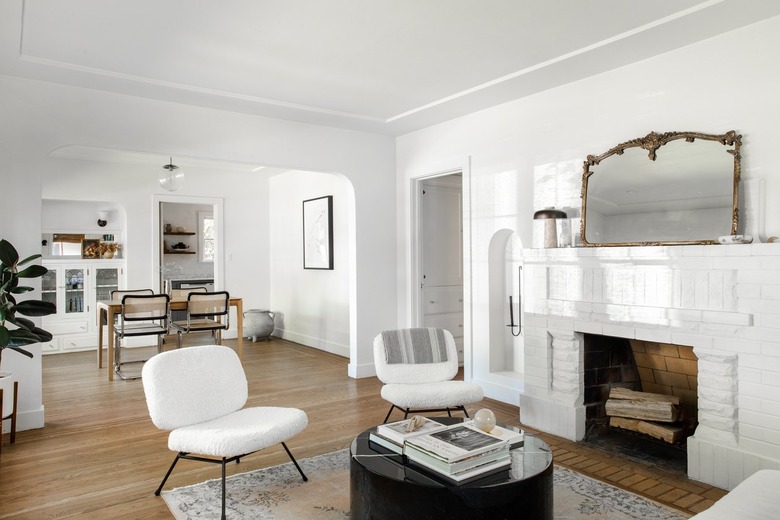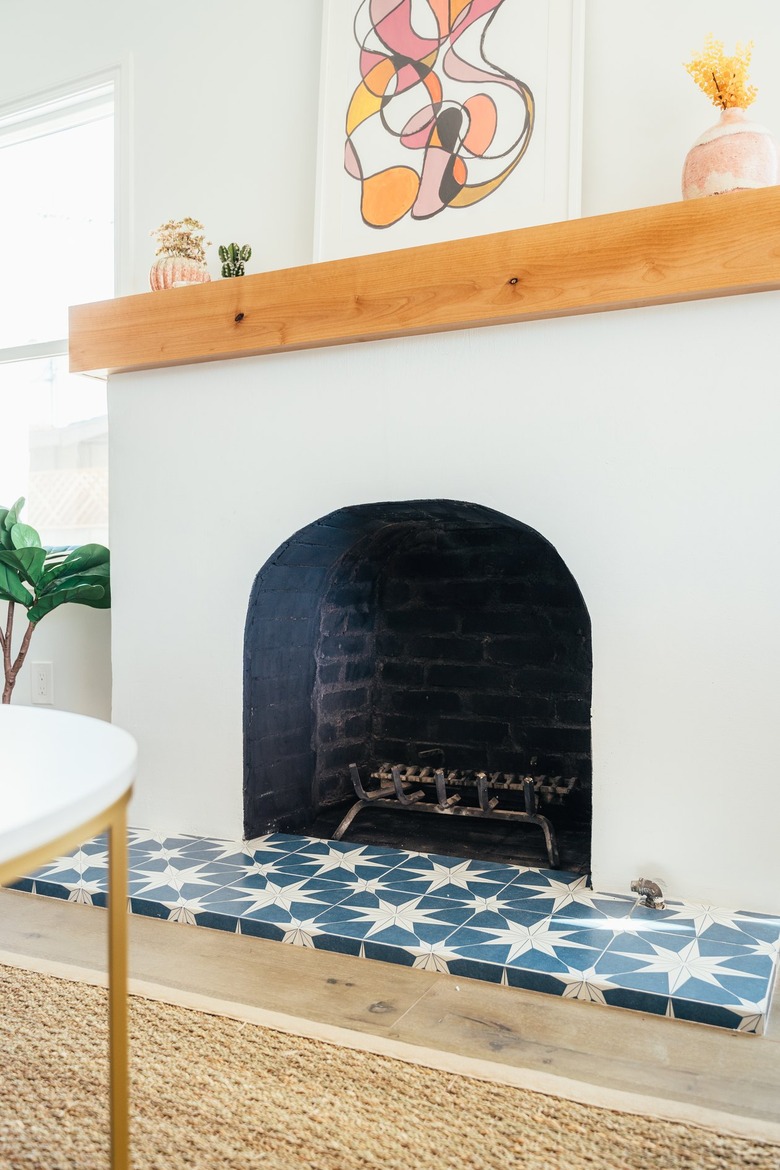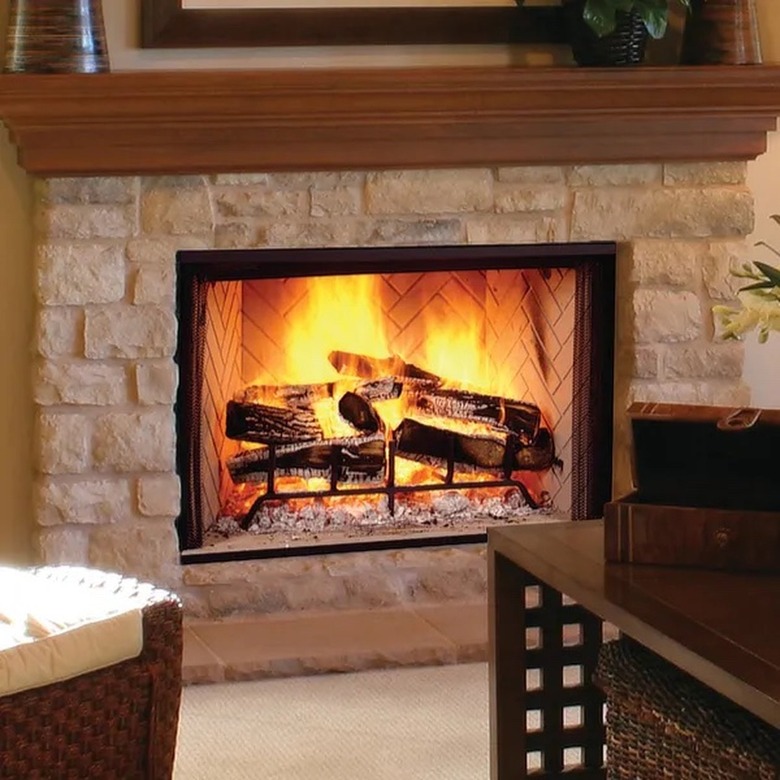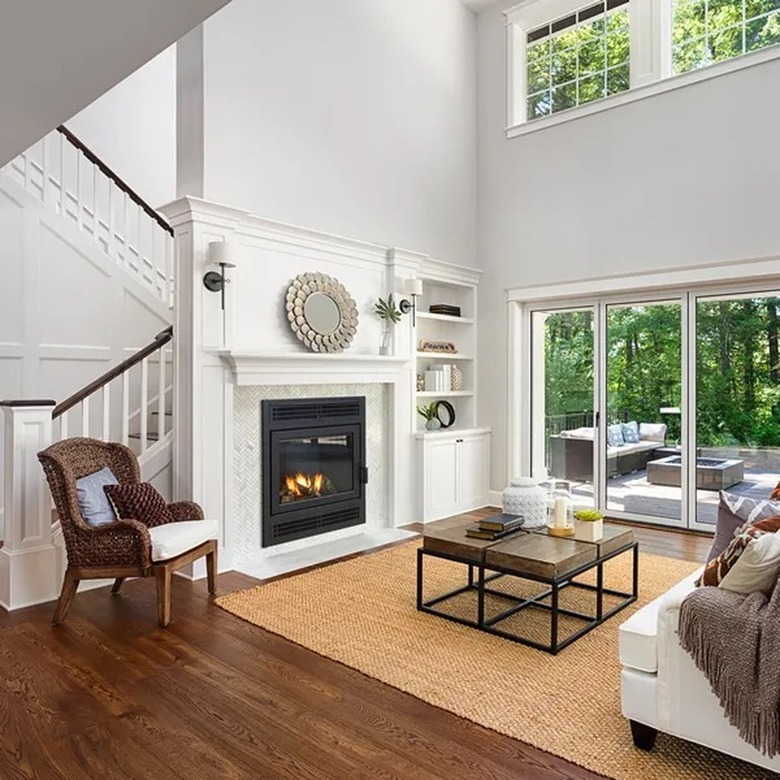The 4 Types Of Wood-Burning Fireplaces For Cozy Nights In
We may receive a commission on purchases made from links.
The look, sound, feeling, and aroma of a cozy wood-burning fire is an experience unlike any other. There are many types of wood-burning fireplaces available — and if you are considering adding a fireplace to your home or upgrading the one already in your house, you need to know what options are going to work best for you.
The wood-burning fireplace you choose should be based not only on your budget but also on how you plan to use the fireplace, particularly whether you plan to use it mainly for ambiance or as a heat source.
1. Open-Hearth Fireplaces
1. Open-Hearth Fireplaces
An open-hearth fireplace, also called a masonry fireplace, is what most people envision when they think about this home feature. These are the most traditional of all types of wood-burning fireplaces. In fact, most pre-1980s homes that feature fireplaces have open-masonry fireplaces. These are typically made from brick or stone with a large hearth to catch any embers that may escape from the firebox, which is the area where the wood burns.
The damper (or the metal plate or cap that's just inside the flue) must be opened before use to allow smoke to enter the chimney, first going into a smoke chamber to cool before it exits the house. Most masonry fireplaces are decorative, and many feature a large shelf above the firebox, better known as a mantel. This element may be made from wood, stone, concrete, brick, or other materials.
The Pros and Cons
Open-hearth fireplaces are widely celebrated for their classic beauty and ambiance, adding a lovely focal point to any room. Masonry fireplaces allow the light, heat, sound, and aroma of a fire to enter a room directly, creating a rustic, relaxing mood.
Unfortunately, the aroma the fire isn't exactly healthy, as it leaves you breathing dangerous chemicals, and that's only one of their drawbacks. They are also one of the least safe types of wood-burning fireplaces, a highly inefficient means of heating a home, and very expensive to install.
It's interesting to note that the iconic smell so many people love from a fireplace is actually a combination of air pollutants, such as carbon monoxide, formaldehyde, benzene, acrolein, and particulate matter. In fact, open hearths can release up to 50 grams of particulates per hour. That's why people with asthma, COPD, and heart conditions as well as pregnant women and young children are best off avoiding rooms with active masonry fireplaces.
Aside from the dangers presented to a person's health, these fireplaces can be a serious safety hazard since embers or burning logs sometimes escape the firebox and land somewhere past the hearth, causing a fire. This is why it is always advisable to install a metal mesh screen or glass doors in front of the firebox.
When it comes to the design's inefficiency, the bottom line is that a great amount of heat simply escapes up the chimney, whereas other types of wood-burning fireplaces better trap the heat, more effectively warming your home. Because open-hearth fireplaces are so inefficient, the Environmental Protection Agency (EPA) considers them to be decorative in nature, and therefore, they are exempt from the agency's emissions standards. It's also worth noting that due to their fire risk and low-efficiency ratings, many municipalities have outlawed the building of new open-hearth fireplaces.
The Costs
Masonry fireplaces are notoriously expensive to install since they must be built on-site by a specialized team of masons. They are typically only added during new construction of a building because retrofitting a foundation to support the weight of a new fireplace can add substantial expense. Adding a new masonry fireplace to a new structure will usually cost upward of $5,000, and adding an authentic brick fireplace to an existing home can easily cost over $10,000. If you need to update the foundation to support a fireplace, expect to pay upward of $30,000. Remember that due to their inefficient nature, these fireplaces require more wood to keep burning, which means they also cost more money over time.
The bottom line is that if you are looking for a fireplace that's mostly there to add to the ambiance of a room and budget is no concern, a masonry fireplace may be a good option. Otherwise, you should consider one of the other types of wood-burning fireplaces instead.
2. Prefabricated Fireplaces
2. Prefabricated Fireplaces
Also called "low mass" or "zero-clearance" fireplaces, this type of wood-burning fireplace is very similar to an open-hearth design — only it is not built from masonry materials on-site. Instead, it is built from metal in a factory. It still has many of the same parts, including a hearth, firebox, damper, and flue, but because the parts are preassembled and shipped to the installation site, it is much easier and less expensive to install than a masonry fireplace.
The Pros and Cons
Like masonry fireplaces, prefabricated models are designed more for ambiance than their ability to heat the home, but because they can include features such as insulated walls, blower motors, and double burn systems, they are often more efficient than traditional open-hearth fireplaces. In addition, while they are still exempt from EPA emissions standards, many manufacturers voluntarily meet these requirements, earning them the label of "EPA qualified." This means that among other things, they cannot emit more than 2.5 grams per hour of particulate matter, meaning they emit 96 percent less particulates than open-hearth fireplaces, providing for dramatically better air quality compared to traditional fireplaces.
On the downside, prefabricated fireplaces simply don't last as long as a traditional masonry fireplace. Typically, they last about 10 – 15 years with proper maintenance — whereas a masonry fireplace can last as long as the house is standing.
The Costs
A prefab fireplace typically costs around $3,000 including installation and does not require any retrofitting to the foundation in order to support its weight. Many are installed with a vent pipe rather than a traditional chimney, making installation easier and less expensive.
3. Wood-Burning Fireplace Inserts
3. Wood-Burning Fireplace Inserts
In an older home equipped with a masonry or outdated prefab fireplace, you don't need to settle for an inefficient fireplace that pollutes your home. If you want to upgrade your existing fireplace to increase its heat output, reduce fire danger, and decrease the amount of particulate emissions, look into fireplace inserts. These are sealed steel or cast-iron fireboxes fitted with glass doors that fit in the firebox of your existing fireplace, improving the efficiency of the fireplace while taking advantage of the already-built framing and chimney to save money on installation.
While you can always install an electric or natural gas fireplace insert in a masonry fireplace, many homeowners choose to stick with a wood model. It's worth noting that if you have a zero-clearance fireplace, you must select a fireplace insert specifically designed for this type.
The Pros and Cons
Unlike traditional fireplaces, wood-burning fireplace inserts are not considered decorative elements in a home but actual heaters. This means they must meet EPA requirements for efficiency and emissions. When properly constructed and installed, they could reduce the number of pollutants from an open-hearth fireplace by over 90 percent. Most models also include blowers to increase the fireplace's efficiency as a source of heat by sending hot air further into the home. In addition, they are safer than open-hearth fireplaces because they contain the embers and logs from a fire, dramatically reducing the risk of a fire breaking out.
On the flip side, wood-burning fireplace inserts can look a bit utilitarian and won't give you the vintage aesthetic that traditional masonry fireplaces and even prefabricated fireplaces can give you. However, if your primary goal is to have a safe way to keep warm, an insert might be the ticket.
The Costs
Fireplace inserts are an affordable upgrade that can dramatically increase the efficiency and safety of a traditional fireplace with minimal renovations. Depending on the model and the condition of your fireplace, purchase and installation will cost between $2,000 and $5,000, with the higher price range applying in cases where a chimney liner must be installed.
4. Wood-Burning Stoves
4. Wood-Burning Stoves
One of the oldest heating technologies after the classic open-hearth fireplace — the wood-burning stove — has been around since the 16th century. They gained widespread popularity until Benjamin Franklin improved the design to heat a room faster than a traditional fireplace (while using only a quarter of the wood).
The Pros and Cons
Though the technology may be nothing new, wood-burning stoves continue to be more efficient and safer than traditional fireplaces, and because they are freestanding, they offer the benefit of being able to be placed anywhere in a room that has sufficient clearance space, even where a fireplace would be impractical.
Wood stoves are so effective at heating even large spaces that they remain the sole heating source for many homes, even in notably cool climates. They are particularly beneficial in remote areas where natural gas, propane, and electricity are not readily available. Many of these stoves are even equipped with burners so they can be used as a cooking surface.
Like fireplace inserts, wood stoves are required to meet EPA efficiency and emissions restrictions. Many are equipped with blowers to more effectively spread the heat throughout the room, and some high-end models have double- or triple-burn systems, meaning that smoke, particulates, and gases that would normally be vented out of the home are captured and burned up, producing more heat while further reducing the amount of pollutants emitted.
It's worth noting that if you purchase a catalytic double- or triple-burn model, the catalyst requires more maintenance and will typically need to be replaced every few years. Even without special upgrades, though, the stove's design naturally reduces the amount of wood that needs to be used in the device and reduces the amount of pollutants and sparks that can escape, meaning they are more eco-friendly and safer than standard fireplaces.
The Costs
Wood-burning stoves can be found for anywhere from $325 all the way to $4,000 depending on the specific model's size and technology. Installation typically costs between $3,000 and $4,000, which includes installing a concrete slab or hearth pad under the stove and adding a venting space in the roof for the stovepipe flue. It's worth noting that installation can cost significantly more if the foundation needs to be reinforced to support the weight of a concrete slab or hearth pad and a cast iron, steel, or stone stove, which can easily exceed 1,000 pounds.




